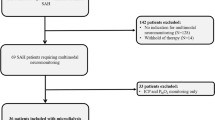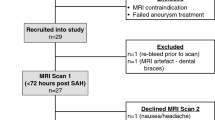Summary.
Objectives: To look for evidence of early ischaemic neurochemical changes in patients suffering severe traumatic brain injury (TBI) and severe subarachnoid haemorrhage (SAH). Proton metabolite concentrations were measured in normal and abnormal areas of brain on T2 MR imaging, in regions considered particularly vulnerable to ischaemic injury.
Methods: Intensive care patients underwent T2 weighted imaging in a 1.5 Tesla MR scanner and proton magnetic resonance spectroscopy (single voxel or chemical shift imaging). Metabolite values in areas that appeared `normal' and `abnormal' on T2 MR imaging were compared with those obtained from normal controls.
Results: 18 TBI and 6 SAH patients were imaged at 1 to 26 days. N-acetyl aspartate (NAA) was lower in TBI and SAH patients compared to controls in both T2 normal and T2 abnormal areas (p<0.0005). SAH, but not TBI patients also had increased choline and creatine compared to controls in the T2 normal (p<0.02, p<0.02 respectively) and T2 abnormal (p=0.0003, p=0.003) areas. No lactate was found in TBI or SAH patients.
Conclusions: Significant loss of normal functioning neurones was present in TBI and SAH, but no evidence of anaerobic metabolism using lactate as a surrogate marker, questioning the role of `ischemia' as a major mechanism of damage. Increased choline and creatine were found in SAH patients suggestive of increased cell-wall turnover. Current theories of brain injury after TBI or SAH do not explain these observed neurochemical changes and further research is required.
Similar content being viewed by others
Author information
Authors and Affiliations
Additional information
Published online September 2, 2002
Acknowledgments We thank Mr J. Cannon, radiographers, nursing staff and porters for their help, Mr M. Connell for computing support and Mrs P. Jones for assistance with demographic data. The CSI data has been presented in part to the Neuroanaesthesia Societies of Great Britain, Ireland, Scandinavia and Finland, Helsinki 1998 and a technical paper published by Wild J. et al.: Magnetic Resonance Materials in Physics, Biology, & Medicine 8(2): 109–115, 1999.
Correspondence: Dr. Carol Macmillan, University Department of Anaesthetics, Ninewells Hospital, Dundee DD1 9SY, UK.
Rights and permissions
About this article
Cite this article
Macmillan, C., Wild, J., Wardlaw, J. et al. Traumatic Brain Injury and Subarachnoid Hemorrhage: In Vivo Occult Pathology Demonstrated by Magnetic Resonance Spectroscopy may not be “Ischaemic”. A Primary Study and Review of the Literature. Acta Neurochir (Wien) 144, 853–862 (2002). https://doi.org/10.1007/s00701-002-0966-x
Issue Date:
DOI: https://doi.org/10.1007/s00701-002-0966-x




